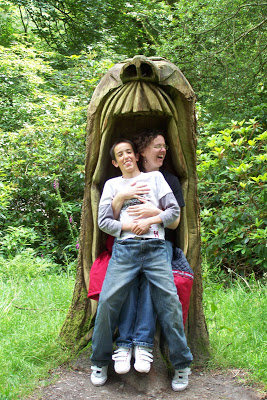Something you need to know about me: I’m a big fan of snuggling! Anything to put-off getting out of bed and delay the morning rush-to-school routine, especially on rainy mornings. Snuggling is one of the most important ways I have bonded with my children. And a secure parent-child bond you now know is highly correlated with being well-adjusted and being less likely to engage in risky behaviors. Even more importantly, securely attached kids are more likely to possess emotional and social courage.
Knowing what I do about the importance of physical touch and affection to help us human beings stay connected, I still sneak in as many hugs as I can. And, with resignation, I accept my kids’ need for more space at times and cherish those momentary hugs. Each time my kids now eschew my embraces, I secretly want to clutch my chest and fall dramatically to the floor—mostly for the hopeful effect of changing their minds. I can be kind of manipulative when it comes to getting my needs met. Lucky for my kids, I’m a little more evolved than that. I also know all the important stuff about honoring our kids’ boundaries. Eight years of psychology graduate school will drill good interpersonal boundaries, if nothing else, into you. It’s very important that we take our kids lead when it comes to their need for physical space and privacy as they grow—even if it means you being the first to shut the bathroom door for privacy.
 |
| Copyright Andres Rodriguez, Dreamstime.com |
I’m relieved when I tell a friend that my snuggling days may be over, and she shares that her fourteen-year old daughter still crawls into bed on Saturday mornings to chat about her week. I love seeing a very tall, and in my books very cool, college student wrap his/her arms lovingly around a parent walking down the street. These snugly kids aren’t wallflowers in life. They aren’t weak because they still want their parents’ arms around them. On the contrary, securely attached children waltz into the world with confidence.
In some ways one of my primary “love languages” (physical touch), according to Dr. Chapman (1992), is now shifting to match my children’s desire for words of affirmation, quality time, acts of service, and/or receiving other gifts I have to offer (not just material goods!) Click here and you can take Dr. Chapman’s assessment to figure out your primary love language. Dr. Chapman is a pastoral and marriage counselor who believes that we all have five common love languages to express our care and love, some of us favor one or more particular love expressions over others…you can decide if his work is useful to you after taking the assessment.
Fortunately for me, and I believe for my daughter, her decision to cut off snuggles only lasted about a week. The first sign of social or homework distress at school, she was back in my arms to confide her troubles and share her successes. And we’ve been reading books together again at bedtime, when we can, to make sure to have connect time at the end of the busy days.
So, since snuggling’s back on…my girl crawls in beside me when I decide to have a quick nap yesterday. She’s been feeling sick this week and particularly soft, open, and slightly vulnerable. We relax into a kind of meditative state where we both access our most heartfelt questions and cares.  I ask her, “Do you think I’ve raised you to be courageous in life?” (I know…it’s a loaded question now that she sees me writing a blog, researching, and coaching parents about nurturing courage in kids.) Fortunately, for me, she’s fiercely loyal and always tells the truth. “Yeah, mom, you have. You don’t prevent me from trying new things because you are worried I might hurt myself. You don’t fuss over us like that. And you don’t push me too hard. Like the way you’ve helped me with riding roller coasters. You respect that I don’t like them, but keep offering me the chance to ride with you if I want to. You let me make my own choice. And because you do that, it makes me want to try new things. It makes me trust myself.”
I ask her, “Do you think I’ve raised you to be courageous in life?” (I know…it’s a loaded question now that she sees me writing a blog, researching, and coaching parents about nurturing courage in kids.) Fortunately, for me, she’s fiercely loyal and always tells the truth. “Yeah, mom, you have. You don’t prevent me from trying new things because you are worried I might hurt myself. You don’t fuss over us like that. And you don’t push me too hard. Like the way you’ve helped me with riding roller coasters. You respect that I don’t like them, but keep offering me the chance to ride with you if I want to. You let me make my own choice. And because you do that, it makes me want to try new things. It makes me trust myself.”
Keep offering up those hugs, your listening presence, and modeling the emotional and social courage it takes to be truly connected with family and friends…and know it’s a healthy sign of your kids’ own development when they feel safe enough to say “No”, “I need some space”, or “I’m not ready to try the roller coaster (or whatever the courage challenge may be) yet.”

